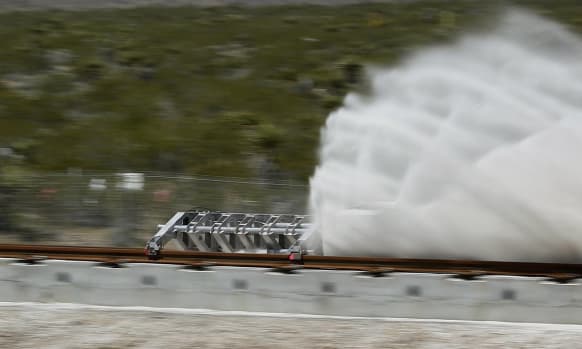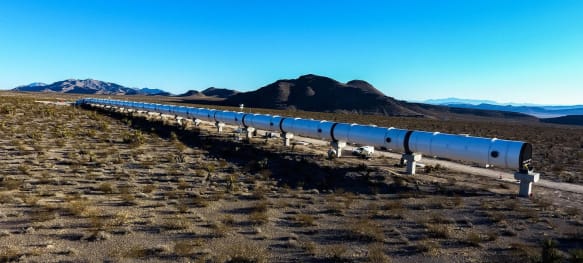HypED: A Summary So Far
Follow articleHow do you feel about this article? Help us to provide better content for you.
Thank you! Your feedback has been received.
There was a problem submitting your feedback, please try again later.
What do you think of this article?
What is Hyperloop?
Hyperloop is on track to be the next great transformation in mass transportation. The concept is simple: a network of on-demand, electrodynamically levitated pods travelling in evacuated tubes at 95% of the speed of sound. The term 'Hyperloop' was first coined in 2012 by technology billionaire and serial entrepreneur, Elon Musk. It is a radically new concept of point-to-point travel at speeds over 700mph, covering the distance between Edinburgh and London in 35 minutes.
The image above shows travel times with stops included at all nodes. Although individual components of Hyperloop technology have been around since the 90s, collaboration has been accelerated through an international design competition, encouraging innovation from teams around the world. This competition is being run by Musk's space exploration company, SpaceX, with the finals taking place in California in August 2017. HypED, the student team from the University of Edinburgh, are one of 24 finalists in the SpaceX competition. This article marks the first diary entry of the HypED team on their journey in the lead-up to the competition; here we will share the status of the team, the questions that arise and the decisions we make moving forwards.
How could Hyperloop influence the way that we travel in the future?
The implications of a Hyperloop corridor are immense; intercity commuting becomes comparable to taking the metro, injecting economic stimulus throughout the country and creating a super-productive population. Beyond connecting cities, Hyperloop has the potential to combine separate airports into terminals of an integrated airport network. This tackles the very real issue of airport expansion, seen clearly with Heathrow Airport which currently operates at 98% capacity. With the advance of autonomous vehicles, Hyperloop provides the arterial connections that will allow fully automated, on-demand travel. An autonomous vehicle is ordered from your phone which then delivers you to the correct Hyperloop pod for your onward journey. At the end station, another autonomous vehicle drops you off at your final destination.

How close is it to becoming a reality?
Although the Hyperloop technology is advancing rapidly, there is still considerable ground to cover before a fully operational system will carry its first passengers. Within the five years since Elon Musk popularised the idea, significant investment has been directed into design and feasibility studies from student teams, major infrastructure companies and venture backed US companies alike. Several groups are manufacturing the first Hyperloop prototypes ever made, most notably Hyperloop One and Hyperloop Transportation Technologies.
In May 2016, Hyperloop One tested their levitation and propulsion system in Nevada, accelerating their vehicle from rest to 187km/h in 1.1 seconds.
More recently, the company has built a full-scale, 500-metre test track called DevLoop which will allow more accurate testing of the technology.
Several governments have explicitly expressed interest in advancing Hyperloop in their own country. For example, the Minister of Infrastructure and the Environment for the Netherlands, Melanie Schultz van Haegen, fully supports the development of the Hyperloop and is conducting studies on its feasibility for the Netherlands.
Why is there a University of Edinburgh team?
Interest about Hyperloop in the University of Edinburgh began when the first SpaceX competition was announced in 2013. This marked the beginning of a series of successes and the momentum of these events has grown HypED's maturity, strength and numbers.HypED consists of two distinct teams: technical and commercial. This helps us to focus our fifty members on all aspects of Hyperloop, from computational fluid dynamics to negotiating government policy. All our members are highly driven with a passion for advancing Hyperloop and bringing its numerous benefits to any country adopting the transport system. Our team of 50 students come from various backgrounds with members from every School in the University of Edinburgh except the School of Divinity, but even this is expected to change.
Over the past three years, we have worked closely with University and have support from School of Engineering and the Head of the College of Art, Social Sciences and Humanities. HypED ran a showcase event in October 2016 with approximately 250 attendees and reaching 3,400 people online. In addition to this, we have delivered educational workshops within the university and created two summer research opportunities for undergraduate students.
The team's success has prompted discussions with government institutions such as the Department for Transport, Innovate UK, and HM Treasury amongst others. The desire of the HypED team to continuously innovate has clearly resonated within various engineering industries, attracting partnership opportunities with RS Components, Cirrus Logic and Costain.
In essence, HypED exists to break the boundaries of transport infrastructure and to innovate solutions for the future. We strive to advance Hyperloop in every way and continually surprise ourselves with our expertise and abilities in this new and advancing field of engineering.
Which competitions have we been involved in? How have we done?
The first competition we entered was the SpaceX technical competition in 2015, winning the award for Subsystem Technical Excellence. This achievement saw the technical team of HypED flying to Texas in January 2016 to showcase designs where judges recognised their ideas for modular capsule design and the passenger (un)loading process.
The commercial team recently attended the 'Vision for Europe' event in Amsterdam, the semifinals of the Hyperloop One Global Challenge; we were selected as 1 of 35 semifinalists from over 2600 entrants. The results from this competition are being eagerly awaited with our presentation being remarked as 'complete and excellent' by the Hyperloop One judging panel.
We are now finalists in the second SpaceX competition, which culminates in displaying a working Hyperloop pod on a test track in California this August 2017.
What are we working on now?
Our primary focus at the moment is to manufacture, test and ship a working Hyperloop pod in preparation for the second SpaceX competition in August 2017. The pod, once born, will be called Poddy McPodface. Main production and assembly processes are being carried out at the School of Engineering of The University of Edinburgh and we have members working around the clock to complete the assembly.
Holidays and internship arrangements make things more difficult but the work is steadily progressing and we are now integrating all components together and testing subsystems. Moreover, there is considerable logistics work involved in arranging pod shipment, work plans for California and organising travel for members. Our commercial team refuses to slow down operations and is laying a path for the team to proceed in the months and years to come.
More details to come in subsequent DesignSpark blog posts!
What does it feel like to be involved in such potentially influential new technology?
It is both remarkable and inspiring to be responsible for delivering a more productive, environmentally conscious, and connected society for the future. We are delighted by our success to date, coming as a direct result of hard work and sleepless nights from our team of students.
Hyperloop capability fuels imagination and we inspire numerous individuals to work with us and support our project; this is both motivating and empowering for our team members. We all look forward to the day the first commercial Hyperloop is installed and knowing that we played our part in making it a reality.
Want to find out more? The HypED team will be blogging frequently on DesignSpark over the coming months. To follow their journey, why not sign up to the DesignSpark newsletter and get updates from the team as soon as they are posted. Click here to register.
Article Writer: Duncan Webb






